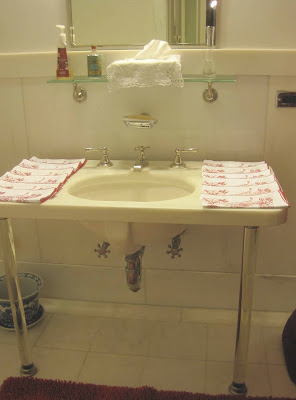As I mentioned in my previous post, I recently toured the Belgium ambassador's residence with the ICAA. Designed by Horace Trumbauer's firm (or more specifically by his chief architect Julian Abele) for Anna Dodge Dillman, the house was meant as a wedding gift for her daughter Delphine to her second husband, Raymond T. Baker. Sadly they only lived in the house for four short years.
After Baker's death, Delphine rented the house to a roster of who's who before finally she herself passed away at only 43. Her mother shortly thereafter sold it to the embassy of Belgium who have been in trust of the house since 1945.
These gorgeous interiors you see were designed by the Paris interiors firm of Alavoine et Cie. The entry hall, seen above, may look like it has stone walls but they are in fact molded plaster. The floors however are marble.
Immediately to the left of the foyer is the stairhall. This room sets the tone for the ground floor with panel moulding in pastel colors of the time and amazing detail work such as the iron railing.
I love how the paneling is justified under the stair to different heights. The panels are an excellent organizational system as they hide any number of storage doors, vents, and other utilitarian devices.
A lovely thing to see before going upstairs, no?
The parquet flooring, chandeliers, and carved paneling was imported from France by Alavoine et Cie. The first ambassador, Baron Silvercruys, hired the firm yet again to complete the space to their original design after many items and furnishings had been removed during the sale and multiple rentals.The Belgium ambassador frequently teases the French ambassador for having a more French house than him!
Again I have to point out the beautiful bronze hardware - architectural jewelry!
This tiny paneled vestibule separates the stairhall from the men's powder room. Yes there are two, one for men and one for women; a common design element in such formal houses at the time period.
This tiny vestibule may be my favorite space of the house, so precisely decorated like a small jewel box.
On the opposite side of the entry foyer is the women's cloak room, seen below.
I immediately think of the iconic Cecil Beaton photograph of models in Charles James gowns when I see this room as I imagine this was the setting for many similarly elegant scenes.
The slightly open door to the right leads to the powder room while the panel to the left is actually a jib door and hides a coat closet, full of coats and wellies (yes I looked!).
This built-in dressing table survives and is surely the most elegant piece of furniture in the entire house.
All of the bathrooms feature these custom designed marble sinks with glass legs - they epitomize 1931 bathrooms for me.
I'll leave you with a last photograph of the ladies cloak room (notice the multi-colored umbrellas in the corner and my reflection in the mirror). Look for post 2 soon which will feature the Dining Room and Salon, said by many to be the most beautiful room in Washington!
















